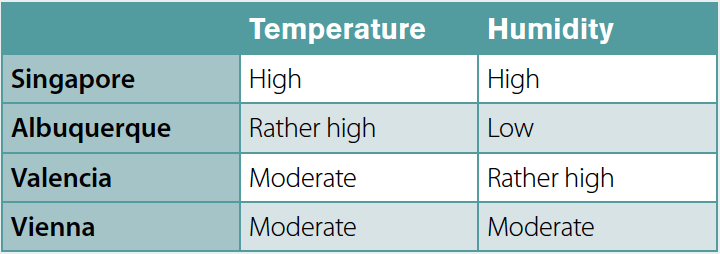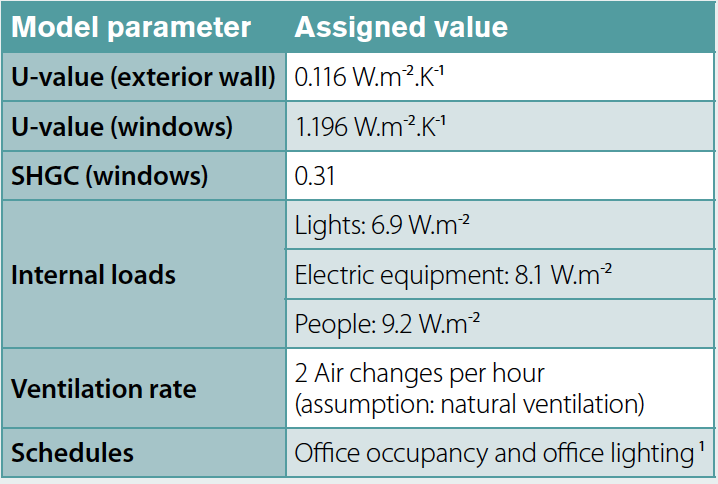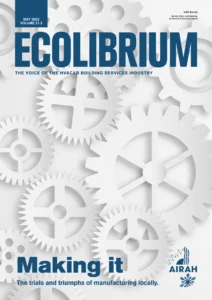Exploring the potential of personal radiant cooling systems

Abstract
The combined effects of phenomena such as global warming and urban heat islands have led to a significant increase of cooling energy use. For this reason, there is a need for innovative space cooling strategies. Radiant cooling technologies are often promoted for their potential to provide thermal comfort as well as their energy efficiency potential. As a result, radiant cooling technologies might contribute to addressing the aforementioned challenges. Nonetheless, when implementing radiant cooling systems, multiple issues (e.g., condensation risk) need to be considered.
This contribution explores an alternative radiant cooling solution, which addresses these challenges by:
i) placing radiant cooling panels close to occupants, and
ii) including systems to accommodate surface condensation.
A computational case study was conducted to assess the panels’ effect on occupants’ thermal comfort. This was done for four different locations: Singapore, Vienna, Valencia, and Albuquerque. The results point to the potential of the personal radiant cooling solutions toward improving occupants’ thermal comfort.
Introduction
Climate change has led to the rapid increase of the cooling energy use of buildings. Given the serious consequences of this development, intelligent space cooling solutions are required. In comparison to conventional all-air systems, radiant cooling technologies [5, 6] have often been promoted to improve buildings’ energy efficiency and occupants’ thermal comfort [5 – 8].
Nonetheless, a number of challenges must be considered when radiant cooling solutions are used. One of these challenges includes the coordination of radiant cooling systems with the ventilation systems of buildings. Another challenge concerns the radiant cooling systems’ operational constraints with regard to water vapour condensation risk, which is specifically challenging in hot and humid climatic regions. Due to these challenges, there is a need for innovative radiant cooling solutions. This contribution focuses on an alternative personal radiant cooling approach, which is intended to address the aforementioned challenges [4].
Thereby, the main concept aims at positioning the radiant cooling systems close to occupants (e.g., by using vertically positioned radiant panels). An advantage of this concept is that it can offer the occupants a larger number of personal control options. Moreover, the radiant panel design incorporates features to accommodate potential surface condensation (e.g., via integrated drainage elements). Due to these features, lower panel surface temperatures are possible, i.e., temperatures below the dew point. This is especially relevant for existing, naturally ventilated buildings, which do not have the possibility to include an extensive HVAC system (including dehumidification capabilities).
A computational study
Method
Selected building and locations
This study focuses on the thermal comfort effect of previously proposed personal radiant cooling panels [4] in different climatic conditions. In this context, four locations, which are situated in different climatic regions, were selected – Singapore, Albuquerque (US), Valencia (Spain), and Vienna (Austria). These locations offer a variety of thermal conditions with regard to prevailing temperature and relative humidity levels. Table 1 shows an overview of the hygro-thermal conditions in the four selected locations.
The study was conducted for an office setting. The fictional office space, which was used in this study, has a square-shaped floor area of 100m2 and a room height of 3.5m. It includes four windows (each 5m2 large). It was assumed that the office includes personal radiant cooling panels with a size of 2.25m2. A schematic illustration of the personal radiant cooling panels is shown in Figure 1, whereby two cases are shown. Whereas one case involves one personal radiant cooling panel next to the workstation, the second involves two. The cooling element is positioned 75cm from the assumed users’ seating position. The optional second element is situated at a distance of 100cm from the user.


Table 1. Climatic conditions in Singapore, Albuquerque, Valencia, and Vienna.
Figure 1. Elevation (left) and plan (right) of one or two (illustrated with a dashed line in the plan) personal radiant cooling panels (dimensions in cm).
Simulation of indoor environmental data
Simulations with a popular software [3] were conducted for the aforementioned office setting. These simulations were done for four different locations (Singapore, Albuquerque, Valencia, and Vienna). The aim was to generate data concerning indoor air temperature and relative humidity levels in these locations. Details with regard to the assigned input parameters of the model are shown in Table 2.


Table 2. Specified input parameter for the simulation model
Simulation of indoor environmental data
To evaluate the thermal comfort provision potential of the personal radiant cooling panels, two common thermal comfort indicators were used. These are the predicted mean vote (PMV) and the predicted percentage of dissatisfied (PPD) [2]. The PMV refers to a seven-point thermal sensation scale. It ranges from a subjective evaluation of -3 (“cold”) to +3 (“hot”). Values of - 0.5 and + 0.5 are often used as its recommended limits. For this study, the PMV was calculated in accordance with the elevated air speed method [2]. The study focused on the opening hours of the office space. These are assumed to be between 8am and 6pm. The PMV was calculated on an hourly basis for these working hours over the course of three months (June, July, and August).
To calculate the PMV, we made use of the indoor air temperature and relative humidity values, which were obtained from the simulations. Furthermore, it was assumed that the occupants wear summer clothing. As a result, a clothing value of 0.5 was selected. The metabolic rate of the occupants was assumed to be 1.1 met (typical office work [2]).
The mean radiant temperature was estimated based on the view factor from the user to the radiant panel. In this context, it was assumed that all surfaces surrounding the occupants have a surface temperature, which is equal to the ambient air temperature. The only exception is the surface temperature of the radiant panel, which was set to 12°C in all simulation runs. Moreover, the air flow speed was assumed to 0.2 m.s-1. The effects of a higher air speed (e.g., due to an additional desk fan) was tested as well. For these cases, the air flow speed was set to be 0.7 and 1.0 m.s-1.
The PMV calculations were done for three different situations. First, we explored the thermal situation in the office without a personal cooling panel (base case). Next, the PMV was calculated for a case with one personal radiant cooling panel. Finally, the calculation was made for the case of two cooling elements (see Figure 1).
The main aim of this study was to explore the percentage of time (during the working hours), in which the PMV exceeds the recommended limit of +0.5.
Results
Figure 2 shows the outcome for one of the evaluated situations in Valencia. More specifically, the simulation results (indoor air temperature, surface temperature of the radiant cooling panel, dew-point temperature, as well as the calculated PMV and PPD values) are shown for the case with two personal radiant cooling panels and no additional desk fan (air flow speed: 0.2 m.s-1).
The figure shows that the surface temperature of the personal radiant cooling panels was repeatedly reduced to 12°C to improve users’ thermal comfort. Due to this reduction, the PMV was kept mostly below a value +0.5. However, in some situations, the PMV still exceeded a value of 1. This refers to a subjective evaluation of “slightly warm”. In some cases, the surface temperature of the radiant panel was below the dew point temperature. This suggests that surface condensation might occur, such that appropriate measures could be necessary to collect and remove condensed water.
Moreover, Figure 2 shows an increased PPD in June (corresponding to PMV values below -0.5), which is the result of rather low ambient temperatures and the clothing assumption (typical summer clothing). In a realistic scenario, somewhat higher panel surface temperatures could lead to higher PMV and lower PPD values.
The percentage of time in which the PMV exceeds +0.5 or +1.0 is presented in Figures 3 and 4 (Valencia). The results show that by positioning the radiant panel rather close to the user, the percentage of time in which the PMV exceeds a value of +0.5 is clearly reduced. The increased air flow speed, for instance, via additional fans, can also achieve a significant reduction.
However, note that the cooling potential of fan-driven (convective) cooling has context-dependent limits due to the discomfort risk by the perception of draft. With two personal radiant panels and an elevated air speed, the PMV rarely exceeds a value of +1.0. Figures 5 to 10 show the results for the other three locations.
Figures 5 and 6 illustrate, for Vienna, the percentage of time in which the PMV exceeded +0.5 or +1.0. It is noticeable that the percentage of time in which the PMV in higher than +0.5 is clearly smaller if the personal radiant elements are used. Even, without an increased air flow speed, the PMV exceeds a value of +1.0 less than 1% of the time if two radiant panels are used.
Moreover, the outcome of this study suggest that the personal radiant cooling elements can improve users’’ thermal comfort also in Albuquerque (hot and dry climate). Figure 7 shows that in the base case (no cooling element), PMV exceeds the 0.5 limit about 88% of the time. By using two personal radiant elements combined with an enhanced air flow speed, this value can be reduced to 32% (see Figure 8).
In Singapore (hot and humid climate; see Figures 9 and 10), positioning personal radiant cooling panels could only very slightly reduce the percentage of time in which the PMV was above a value +0.5.
Figure 2. Simulation results for Valencia (air flow speed: 0.2 m.s-1; 2 radiant cooling panels).
Figure 3. Percentage of time in which the PMV exceeds a value of +0.5 (during the assumed working hours) in Valencia.
Figure 4. Percentage of time in which the PMV exceeds a value of +1.0 (during the assumed working hours) in Valencia.
Figure 5. Percentage of time in which the PMV exceeds a value of +0.5 (during the assumed working hours) in Vienna.
Figure 6. Percentage of time in which the PMV exceeds a value of +1.0 (during the assumed working hours) in Vienna.
Figure 7. Percentage of time in which the PMV exceeds a value of +1.0 (during the assumed working hours) in Albuquerque.
Figure 8. Percentage of time in which the PMV exceeds a value of +1.0 (during the assumed working hours) in Albuquerque.
Figure 9. Percentage of time in which the PMV exceeds a value of +1.0 (during the assumed working hours) in Singapore.
Figure 10. Percentage of time in which the PMV exceeds a value of +1.0 (during the assumed working hours) in Singapore.
Discussion and conclusion
This contribution analysed the potential of a personal radiant cooling element on users’ thermal comfort using computational simulation. The explored cooling approach positions radiant cooling elements closer to occupants than conventional radiant cooling systems, such as chilled ceilings. This can provide more personal control options. Furthermore, the proposed solution includes features to accommodate potential surface condensation.
As a result, the radiant panels can have surface temperatures below dew-point. Simulations were conducted for four locations with different climatic conditions. These are Singapore, Vienna (Austria), Valencia (Spain), and Albuquerque (USA).
The aim of this computational study was to assess occupants’ thermal comfort in these four locations. The results point to the potential of the personal radiant cooling solution to improve users’ thermal comfort. The percentage of time in which the PMV exceeds a value of +0.5 during the assumed working hours was clearly reduced in many of the explored situations. The outcome also illustrates the influence of an increased air flow speed on reducing the percentage of time in which the PMV is above a value of +0.5.
Nonetheless, as mentioned earlier, to avoid draft-induced discomfort, maximum air flow speed limits need to be maintained. Figure 11 shows a comparison of the outcome for all locations. In Vienna (moderate temperature and humidity), the results suggest that the percentage of time in which the PMV exceeds the recommended limit of +0.5 can be reduced from 23% to 5% due to two personal radiant cooling elements.
Likewise, in case two radiant cooling panels are used, PMV almost never exceeds a value of +1 (“slightly warm”), even without using an additional desk fan. In Valencia (moderate temperature and rather high humidity), similar results are possible if the two radiant cooling panels are supported by an increased air flow speed (e.g., via a desk fan). As such, the percentage of time in which the PMV exceeds a value of +0.5 is 8% (if the air flow speed is 1 m.s-1). Furthermore, the PMV almost never exceeds a value of +1.0 (“slightly warm”). The results further suggest that radiant cooling panels can also improve occupants’ thermal comfort in the hot and dry climate of Albuquerque (New Mexico, USA).
Without a radiant cooling element, PMV would be 88% of time above a value of +0.5. By using two personal radiant elements combined with an increased air flow speed, this value can be reduced to 32%. Moreover, PMV exceeds a value of +1 only 3% of time. In case of Singapore (hot and humid climate), personal radiant cooling panels could only very slightly reduce the percentage of time in which the PMV exceeds the recommended limit of +0.5. By combining two radiant elements with a desk fan (air flow speed: 1 m.s-1), the percentage of time in which PMV exceeds a value of +1 can be reduced to 47% (base case: 100%).
The aforementioned observations are based on the PMV, which is a “conventional” metric to assess thermal comfort. In the examined situations it was assumed that the office spaces are naturally ventilated. As a result, the full applicability of the PMV concept to evaluate occupants” thermal comfort might have to be revisited. A thermal comfort assessment procedure that is accordingly adjusted might represent a more relevant framework. Specifically in very hot and humid climatic conditions, such an adjusted evaluation procedure could be more favourable with regard to the radiant cooling panels’ thermal comfort provision potential.
In Singapore, for example, the upper limit of the operative temperature (to maintain a satisfaction rate of 90%) is approximately 28°C. Assuming a usage of two personal radiant cooling elements, which have a surface temperature of 15°C, the operative temperature could be kept below 26°C (independent of air flow speed). In this case, increased air flow speed levels might alleviate the negative consequences of a high humidity.
Figure 11. Percentage of time in which the PMV exceeds a value of +0.5 (during the assumed working hours) in Singapore, Albuquerque, Valencia, and Vienna (air flow speed: 0.2 m.s-1).
Acknowledgements
The authors acknowledge the contribution of Dr Matthias Schuß of TU Wien toward the development of code for the computation of PMV values in the present contribution. The authors also benefited from discussions in the context of the IEA EBC Annex 80. The authors also appreciate the opportunity to present the content of this paper at AIRAH’s Outlook 2020 conference in Sydney, Australia.
References
- ASHRAE: ASHRAE Standard 90.1–1989, “Energy Efficient Design of New Buildings Except Low-Rise Residential Buildings”, American Society of Heating, Refrigeration and Air-conditioning Engineers Inc., (1989)
- ASHRAE: ASHRAE Standard 55–2017, “Thermal Environmental Thermal Conditions for Human Occupancy”, American Society of Heating, Refrigeration and Air-conditioning Engineers Inc., (2017)
- EnergyPlus; https://energyplus.net/, (2020)
- Mahdavi, A. and Teufl, H.; “Occupant-centric radiant cooling solutions. Requirements, designs, assessment”, PLEA 2020 (Ed.), Proceedings of the PLEA 2020 Conference, (2020) – to appear
- Rhee, K.N. and Kim, K.W.; “A 50 year review of basic and applied research in radiant heating and cooling systems for the built environment”, Building and Environment, Vol.91, pp. 166–190, (2015)
- Rhee, K.N., Olesen, B.W. and Kim, K.W.; “Ten questions about radiant heating and cooling systems”, Building and Environment, Vol.112, pp. 367–381, (2017)
- Sastry, G. and Rumsey, P.; “VAV vs. Radiant. Side-by-Side Comparison”, ASHRAE Journal, Vol. May 2014, (2014)
- Tian, Z. and Love, J.A.; “Energy performance optimization of radiant slab cooling using building simulation and field measurements”, Energy and Buildings, Vol.41, Issue 3, pp. 320–330, (2009)

This article appears in Ecolibrium’s May 2022 edition
View the archive of previous editions
Latest edition
See everything from the latest edition of Ecolibrium, AIRAH’s official journal.




